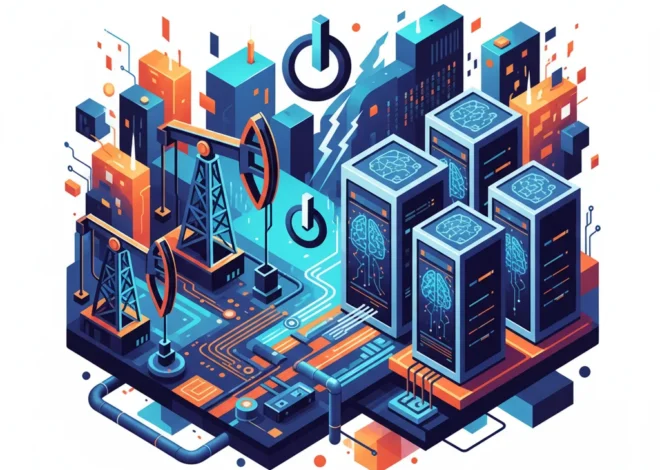
The AI Boom’s Billion-Dollar Power Play: Why Sam Altman is Betting on a Nuclear Startup With No Revenue
We live in an age of digital magic. With a few keystrokes, we can command powerful artificial intelligence to write code, design art, or draft a business plan. This magic, championed by figures like OpenAI CEO Sam Altman, feels ethereal, existing somewhere in the cloud. But behind every seamless API call and every startlingly human-like response from ChatGPT lies a very physical, very power-hungry reality: a massive, global network of data centers consuming a staggering amount of electricity.
And that’s where the magic trick reveals its cost. The AI revolution is on a collision course with our planet’s energy and climate limitations. Sam Altman, more than anyone, understands this. He isn’t just the face of the AI boom; he’s also quietly positioning himself to solve its biggest existential threat. How? By betting on atoms instead of bits. He’s the chairman of Oklo, a nuclear energy startup that has zero revenue, a history of regulatory setbacks, yet is still heading for the public markets with a valuation of $850 million.
This isn’t just another venture capital play. It’s a fascinating, high-stakes story at the intersection of software, hardware, energy, and the audacious belief that technological innovation can solve the problems it creates.
The AI Energy Paradox: Why Your GPT Prompt Needs a Power Plant
For most of us in the tech world—developers, entrepreneurs, and product managers—energy is an abstraction. It’s a line item on a cloud provider’s bill. But the exponential growth in machine learning models is turning that abstraction into a bottleneck. Training a large language model like GPT-4 requires an immense amount of computational power, which translates directly into electricity consumption. And that’s just the training. Every single query, every interaction, requires a network of powerful GPUs to fire up, consuming yet more energy.
The numbers are startling. Some estimates suggest that by 2027, the AI sector could consume as much electricity as a country the size of Sweden. This demand for constant, reliable, 24/7 power is something that intermittent renewables like solar and wind simply cannot guarantee on their own. Data centers need baseload power—a steady, uninterrupted supply. This is the challenge that keeps Silicon Valley executives up at night. How do you fuel an infinite demand for intelligence on a planet with finite resources?
The End of an Era: OpenAI Finalizes its For-Profit Pivot, Reshaping the Future of AI
This is the problem Oklo was born to solve. The company isn’t trying to build the next great SaaS platform or a new programming language. It’s aiming for something far more fundamental: creating a new source of clean, reliable, and—crucially—compact energy.
Oklo’s Vision: Nuclear Power, But Make It Startup-Sized
When you hear “nuclear power,” you probably picture the colossal cooling towers and sprawling complexes of the 20th century. These plants were massive, incredibly expensive to build, and carried a heavy political and social stigma. Oklo is throwing that playbook out the window.
The company specializes in what are known as Small Modular Reactors (SMRs), or more specifically, “micro-reactors.” Their flagship design, the Aurora powerhouse, is designed to be small enough to be transported on a truck. It’s a self-contained unit that uses advanced fission technology to generate clean electricity for decades without refueling. The idea is to move away from centralized, monolithic power grids and towards a future of decentralized, dedicated power sources. Imagine an AI data center, a remote community, or an industrial facility having its own dedicated, carbon-free nuclear battery.
To understand just how different this approach is, let’s compare Oklo’s vision to traditional nuclear power plants.
| Feature | Traditional Nuclear Plant | Oklo’s Micro-Reactor (Aurora) |
|---|---|---|
| Size & Footprint | Massive; hundreds of acres | Compact; can fit in a small building |
| Power Output | 1,000+ Megawatts (MW) | 1.5 to 15 Megawatts (MW) |
| Construction | Custom-built on-site; takes over a decade | Factory-manufactured; assembled on-site |
| Cooling | Requires massive amounts of water | Passive cooling systems (liquid metal) |
| Fuel | Requires frequent refueling | Designed to run for 10-20 years without refueling |
| Use Case | Powering entire cities and regions | Dedicated power for data centers, industrial sites, remote communities |
This shift represents a fundamental rethinking of nuclear energy, treating it less like a piece of national infrastructure and more like a scalable, deployable product. It’s an approach that speaks the language of Silicon Valley: build a standardized unit, automate its operation, and deploy it wherever power is needed. This focus on automation and productization is key to Oklo’s entire business model.
However, let’s not get lost in the hype. This is an incredibly risky venture. Unlike shipping a new software update, you can’t “move fast and break things” with nuclear fission. The regulatory hurdles are immense for a reason, and Oklo has already stumbled badly. Their plan to go public via a SPAC (a “blank check” company) before generating a single dollar of revenue or securing a license is a massive red flag for traditional investors. It screams of the speculative froth we saw in 2021, where exciting stories trumped solid financials. The success of Oklo hinges not on clever code or a slick UI, but on navigating a labyrinth of federal regulations, materials science, and public opinion. It’s a bet that Silicon Valley’s ethos of disruption can be applied to one of the most heavily regulated and conservative industries on Earth. The potential payoff is civilization-altering, but the probability of failure is brutally high.
The $850 Million Gamble: A Rocky Road to the Public Market
For a company with such a bold vision, Oklo’s journey has been anything but smooth. The most significant roadblock came in 2022, when the US Nuclear Regulatory Commission (NRC) took the rare step of denying its first application for the Aurora reactor. The NRC cited a failure to provide sufficient information on key safety and cybersecurity measures, a major blow to the company’s credibility and timeline (source). While Oklo has since resubmitted its application, this initial failure underscores the immense challenge of bringing a new nuclear design to market.
Despite this, the company is pushing forward with its plan to go public by merging with AltC Acquisition Corp, a special purpose acquisition company (SPAC) co-founded by Altman himself. This move allows Oklo to access public market capital without the intense scrutiny of a traditional IPO. It’s a financial maneuver that prioritizes speed and fundraising over proven traction—a common theme among deep-tech startups tackling long-term, capital-intensive problems.
This is where the story gets really interesting for entrepreneurs and investors. Oklo is a pre-revenue, pre-license company in a high-risk industry. Its valuation is based entirely on future promise—the promise of a signed contract with a major tech company, the promise of regulatory approval, and the promise that its technology will work as advertised. It’s a speculative bet of the highest order, fueled by the narrative that the AI boom *must* have a new power source, and Oklo *could* be the one to provide it.
Amazon's Paradox: Why 14,000 Layoffs Are Fueling the Next AI Gold Rush
The Bigger Picture: A Nuclear Renaissance Fueled by Private Capital
Oklo isn’t alone in this pursuit. The nuclear startup space is heating up, with investors pouring more than $17 billion into the sector since 2015. Bill Gates has famously backed TerraPower, a company developing its own advanced reactors. Altman is also an investor in Helion, a startup chasing the even more distant dream of nuclear fusion.
What this signals is a profound shift. For decades, nuclear innovation was the exclusive domain of governments and massive state-backed corporations. Today, it’s being driven by venture capitalists and tech billionaires who see a massive market opportunity in the global energy transition. They are bringing a Silicon Valley mindset—agile development, iterative design, and a high tolerance for risk—to an industry bogged down by inertia.
The ultimate customer for these new nuclear technologies is no longer just the public utility grid. It’s the hyperscale data centers run by Amazon, Google, and Microsoft. It’s the advanced manufacturing plants that require uninterrupted power. It’s the future of computing itself. The demand is clear and growing, and the race is on to see which technology can meet it safely, reliably, and economically.
Amazon's Shocking Pivot: Why 14,000 Layoffs Are Fueling an AI Revolution
Conclusion: A Necessary Bet or a Venture Capital Fever Dream?
The story of Oklo is more than just a tale of a single startup. It’s a microcosm of the incredible challenges and opportunities of our time. It encapsulates the collision of the digital and physical worlds, the urgent need for clean energy, and the audacious ambition of the tech industry to solve humanity’s biggest problems.
Sam Altman’s wager on Oklo is a bet that the same spirit of relentless innovation that gave us artificial intelligence can also solve its monumental energy appetite. It’s a belief that complex engineering and regulatory challenges can be overcome with smart capital and brilliant minds. Whether Oklo becomes a cornerstone of the world’s future energy infrastructure or a cautionary tale of tech hubris remains to be seen. But one thing is certain: as the AI revolution accelerates, the world will be watching, because we’re all going to need a lot more power.


